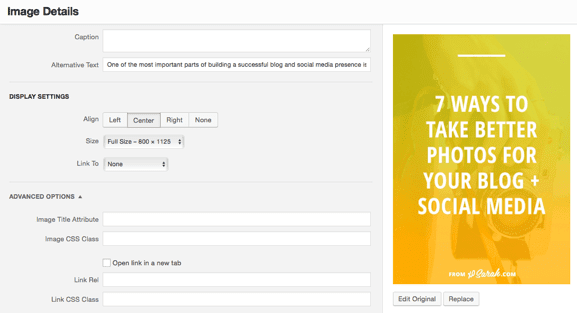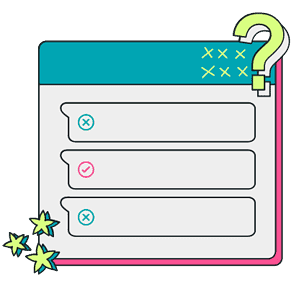Question…are you using Pinterest to share other people’s blog posts…or are you using it to skyrocket your own?
A few years ago, I had boards and boards FILLED with recipe posts and makeup tutorials and design inspiration. And even though I was blogging almost every day, it was rare that I would take the time to pin my own content. And even rarer that I’d see any traffic as a result.
But over the past two years, Pinterest has become the #1 referrer to my site. Absolutely obliterating Facebook, Twitter, and Instagram. Pinterest now brings in over 95% of my traffic from social media and 75% of my overall traffic.
It took some experimenting and strategizing, and lots and LOTS of pinning, but I’ve finally nailed down exactly how to set up my profile, how to design my blog posts, and what to pin to get a serious boost in blog traffic.
And since Pinterest is such a monumental marketing tool for my blog + business, today I want to share 5 steps to get your Pinterest game going too!
Step 1: Prep Your Profile
If you haven’t started using Pinterest for your blog or business yet, and it’s still loaded with recipe posts and outfit ideas and hundreds (or thousands!) of pins completely unrelated to your blog, it’s time to tidy up!
Pinterest shows your pins to other people partially based on what your boards are all about. So if you’re blogging about knitting but the topics of your boards cover 50 other things, you may inadvertently be devaluing your profile, making it less likely for your pins to be discovered.
If you’re still interested in using all the boards you currently have, you could create a completely new account just for your blog or business.
Or, if you’re like me and pretty much used Pinterest for procrastination, you can delete or make secret all the unrelated boards and create new brand-related boards.
Here’s an example of what I ended up with . . .
On-brand boards:


Secret boards: (which, coincidentally, I don’t use for procrastination anymore!)


Step 2: Smart Search Your Way to Better Blog Topics
A popular Pinterest profile and more blog traffic starts with your blog content. The more valuable your posts, the more likely they’ll be re-pinned. And more re-pins equals more traffic!
You can type any topic or phase into the Pinterest search box and it will show you which keywords are currently most popular.
Since I blog about blogging, I use the Smart Search to find out which topics are trending. According to Pinterest, I should be writing posts for beginners, posts about making money from blogging, blog design, or blogging ideas, and how to start a blog.


A two second search and I now have the beginnings of a month of topics!
I could even dive deeper by clicking the keywords . . .


Which can turn into a complete post title like . . .
The Beginner Blogger’s Guide to Making Money Online
How to Start a Lifestyle Blog on WordPress
A Step-by-Step Tutorial on Starting a Blog for Free
Just like using keywords on your blog for SEO, using keywords that are popular on Pinterest makes it more likely that your blog posts will be pinned and re-pinned.
Step 3: Make Your Posts Uber-Shareable
As you’ve probably already realized, Pinterest is all about the images. For your blog posts to have a fighting chance of being seen and pinned, they must follow the rule, “Bigger is better!” Even if horizontal images fit better within your blog posts, you’re going to need to start adding a tall image as well for pin-worthy posts.
For crafty, food, fashion, or design-related posts where all the good stuff is contained within the image, you can get away with skipping the post title. But if your blog post is doing any sort of teaching, then you need to be putting your post title right on the image to make it immediately obvious what someone will gain by reading your post.
If you’re not sure which option will work best for your blog, I always recommend experimentation. Pin one image with the title and one without, and pay attention to your stats to find out which generates the most re-pins and the most traffic.


(Use Nathalie’s link for my Pinterest Powerhouse course and download these image templates as a bonus!)
Step 4: Do The Work For Your Audience in Advance
The best way to grow your traffic and your audience is by creating content that your audience will be excited to share FOR you.
You can make it easy on them by adding share buttons to your blog and then *here comes the important part* adding a description into the alt text for your images.


This way, when a user goes to pin your post, the Pinterest description is already filled in. And not just that, it’s filled it with what YOU want it to say. Because nowadays, with the number of pins in the BILLIONS, people are taking less and less time to rewrite the caption for everything they pin.
So if your image is called “photo123” and you don’t take a minute to add a different description, when one of your readers pins that post, the description will say “photo123.” It might be a brilliant post filled with super valuable info, but with a lame description like that, it’s unlikely that post will see many re-pins!
Step 5: Re-Pin Your Posts Over and Over and Over
Do you know what your “Power Pins” are? It sounds kind of cheesy, but I promise it’s not something I made up. It’s an actual analytic within Pinterest that points to your top pins that generate the most clicks and re-pins.
You can find yours at https://analytics.pinterest.com, click on “Activity from your site,” then click “All time,” and scroll to the bottom.


It’s important that you not only continue to re-pin these pins in order to keep traffic flowing to your site, but it’s also important to create more pins like them.
Do your Power Pins focus on a specific topic? Do they have similar images? Do they help users tackle a certain problem? Do they contain similar keywords?
Whatever those pins are rocking, you need to create more of it!
Outside of your Power Pins, I also recommend re-pinning posts that point to specific things users need to learn about you/from you that will lead them to take a desired action. Do you want them to hire you? Join your email list? Make a purchase? Enroll in a course? Continuously pin content that moves new readers to take those actions.
For my site I cycle through about 15 blog posts that contain content upgrades so I’m continuously moving new readers onto my email list.
And lastly…
The best part of Pinterest is that it’s a content aggregator, which means you:
- Can share the same content repeatedly and still get action from posts from your archives
- You don’t have to create new images and new captions or GO LIVE to make it work
I literally hop on Pinterest for 10 minutes each morning to fill my queue as I eat breakfast. I drop content into my pin scheduler and it automatically pins without me having to check in or comment or do ANY further work to see that effort turn into blog traffic.
If you’re like me and are into tasks that give you MAXIMUM results with minimum effort, then, my friend, you’re about to cultivate a MAJOR crush on Pinterest.
Now, I wouldn’t give you all these instructions and brag about my love for Pinterest without offering to help make it work for you too.
I’ve taken these strategies (explained in much more detail) and directions for joining group boards, designing better blog images, automating your pins (I have over 800 pins scheduled right now!), and turning that traffic into subscribers, customers, and clients, and made them available in my online course Pinterest Powerhouse.
If you’re excited to see how much blog traffic Pinterest can generate for you, head over to the Pinterest Powerhouse site for all the details!
About Sarah Morgan
Sarah Morgan is an Emmy Award-winning digital strategist who’s been blogging and building websites since age 13. Over 20 years later, she’s built a career around helping bloggers and other small business owners kick ass online.
In 2012 she escaped a corporate web design job to run away with the circus (literally!) and strike out on her own. Through her online courses, blog, and books, Sarah strives to help her students and readers build an online presence that fuels their passion for what they do without overwhelm getting in the way. She shares all of her blog and social media-boosting secrets at XOSarah.com and on social media @xosarahmorgan.





